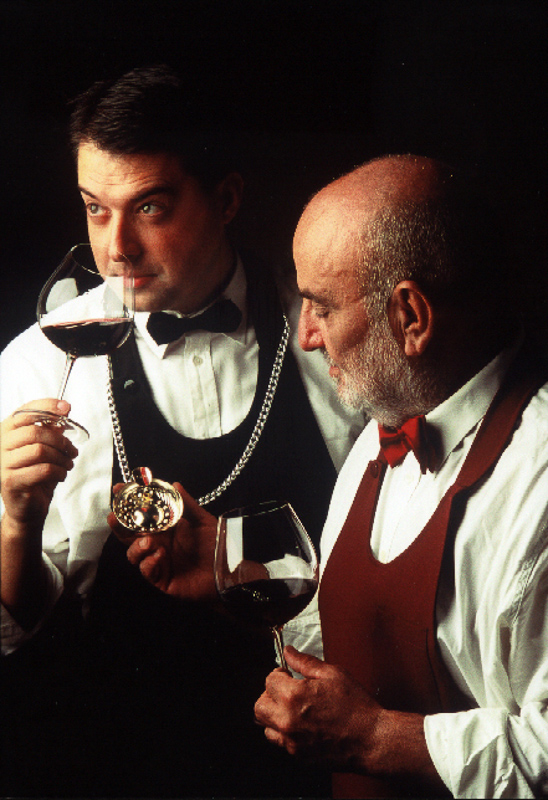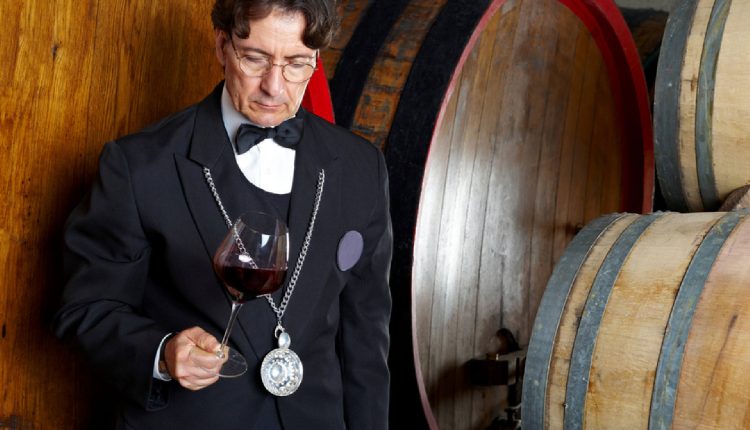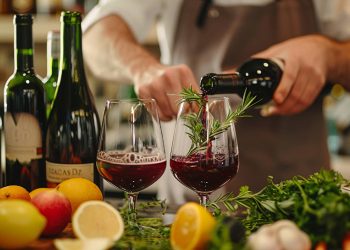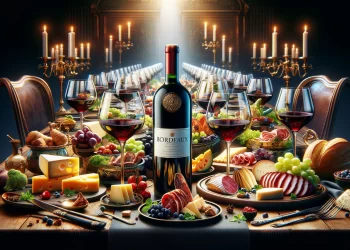In the world of fine dining and wine, sommeliers are often seen wearing a distinctive necklace that piques curiosity and raises questions about its purpose. The necklace worn by sommeliers holds a fascinating history and symbolic significance within the profession, embodying a rich heritage that traces back to the French Royal Court and the reign of Louis XIV. This necklace, known as the tastevin, has evolved from its practical origins to become a ceremonial emblem of the sommelier’s role in enhancing the dining experience. By exploring the historical context, understanding the purpose of the tastevin, and delving into the training and certification of sommeliers, we can uncover the intriguing story behind why sommeliers proudly wear this unique necklace.
Historical Significance of the Tastevin Necklace
The necklace worn by sommeliers holds a significant historical meaning, representing their status and responsibilities. This symbol of the profession’s rich heritage signifies the sommelier’s expertise in wine and their role in enhancing the culinary experience. The necklace serves as a visual reminder of the sommelier’s dedication to their craft and their commitment to guiding guests in their wine selection.
The Tastevin as a Symbol of Status and Responsibility
Worn proudly around the neck, the sommelier’s necklace holds a historical significance as a symbol of status and responsibility within the profession. This necklace represents the sommelier’s dedication to their craft and expertise in the world of wine. It is a tangible marker of their sommelier certification and extensive training to acquire knowledge. In the wine industry, the necklace signifies the sommelier’s role as a trusted advisor, guiding guests in their wine selection and ensuring a memorable dining experience. It is a symbol of their mastery of sommelier skills and their ability to curate a wine list that complements the culinary offerings. T
The necklace is also a mark of distinction, particularly for those who have achieved the prestigious title of Master Sommelier. With this necklace, the sommelier carries the weight of their responsibility and the honor of their profession.
A sommelier wearing a tasteful necklace illustrates the elegance and tradition of this iconic symbol in the world of fine wine. | Credit: D.O. La Mancha
Understanding the Tastevin
The tastevin, a traditional tool of the sommelier, holds historical significance in the world of wine. Originally designed for assessing wine in dimly lit cellars, the tastevin’s shallow, convex shape and faceted metal allowed sommeliers to evaluate color and clarity. Although its practical use has diminished, the tastevin remains a ceremonial piece, symbolizing the sommelier’s expertise and commitment to enhancing the dining experience.
Origins of the Tastevin
The tastevin, a shallow silver cup with facets and a convex shape, has a storied history within the sommelier profession. Originally designed for practical purposes, the tastevin allowed sommeliers to assess the color and clarity of wine in dimly lit cellars. However, it has evolved into a badge of tradition and a showpiece for sommeliers. While its practical use has diminished, some sommeliers still use it to sip a splash of wine and check for flaws.
Today, the modern sommelier is a wine expert who plays a crucial role in wine tasting, wine pairings, and wine service. They are responsible for developing wine lists, delivering wine education, and working with the culinary team to create memorable dining experiences. The tastevin symbolizes the sommelier’s rich heritage and dedication to enhancing their guests’ culinary journey.
Design and Functionality of the Tastevin
The tastevin, a shallow silver cup with a convex shape and faceted metal, serves as both a practical tool and a ceremonial piece for sommeliers. Originally designed to assess wine color and clarity in dimly lit cellars, the tastevin has evolved into a symbol of tradition and prestige. While its practical use has diminished, it remains a showpiece worn around the neck, occasionally used to taste wine and ensure its quality. The design of the tastevin allows sommeliers to showcase their wine knowledge and expertise as they guide guests in wine selection and provide wine consultation and curation. As sommeliers play a dual role as floor managers, the tastevin visualizes their authority and professionalism in the world of wine.
The Role of Sommeliers in Contemporary Wine Culture
The role of sommeliers in contemporary wine culture is multifaceted and influential. Beyond their traditional responsibilities of selecting and serving wines, sommeliers play a crucial role in enhancing the overall dining experience for guests. Their extensive knowledge and expertise in wine pairings can greatly contribute to the enjoyment and appreciation of wine, making them an invaluable asset in modern dining establishments. Additionally, sommeliers have the ability to educate and inspire guests, fostering a deeper understanding and appreciation of wine in today’s wine culture.
Sommeliers in Modern Dining Establishments
In today’s modern dining establishments, sommeliers play a pivotal role in enhancing the wine culture and creating an enriching dining experience. They are the wine stewards who bring professionalism and expertise to the table, ensuring that guests have a memorable wine experience. The sommelier’s job involves curating wine lists, recommending pairings, and providing knowledgeable service. They bridge the gap between the kitchen and the dining room, adding a touch of sophistication to the overall wine culture of the establishment.
The Impact of Sommeliers on Wine Appreciation
Sommeliers have significantly impacted the appreciation of wine, with their expertise and passion elevating the role of the tastevin in contemporary wine culture. Through their extensive knowledge and training, sommeliers are able to guide wine enthusiasts in understanding the complexities of wine flavors and varieties. They play a crucial role in wine events, providing recommendations and enhancing the overall experience. Their expertise is also demonstrated through their success in the sommelier exam, which further solidifies their credibility in the world of wine.
Training and Certification for Sommeliers
Training and certification are essential components of the sommelier profession, providing individuals with the knowledge and skills needed to excel in their roles. Sommelier courses and certifications offer a comprehensive education covering topics such as wine production methods, wine-tasting techniques, and food and wine pairing. The journey to becoming a Master Sommelier is rigorous and requires years of study, experience, and dedication.

Overview of Sommelier Courses and Certifications
Sommelier courses and certifications offer comprehensive training and education for individuals aspiring to become professional sommeliers. These programs provide a structured curriculum covering a wide range of fine wines, wine cellar management, wine serving, and wine classes. Here is an overview of sommelier courses and certifications:
Certification Programs:
- The Court of Master Sommeliers: Offers various levels of certification, including the prestigious Master Sommelier Diploma.
- International Sommelier Guild (ISG): Provides comprehensive wine education and certification programs.
Wine Courses:
- These courses cover topics such as wine production, grape varieties, wine regions, and wine-tasting techniques.
- Students learn about food and wine pairing, wine service, and wine list development.
Practical Training:
- Sommelier programs often include hands-on experience, allowing students to apply their knowledge in real-world settings.
- Students may have the opportunity to work in restaurants or attend wine events to gain practical skills.
The Journey to Becoming a Master Sommelier
After gaining a solid foundation in wine education and certification programs, individuals can embark on the journey to becoming a Master Sommelier, the pinnacle of achievement in the sommelier profession. This journey requires dedication, extensive knowledge, and rigorous training. The table below provides an overview of the training and certification process for aspiring Master Sommeliers:
| Level | Description |
|---|---|
| Introductory | Entry-level certification that covers basic wine knowledge |
| Certified | Advanced certification that includes blind-tasting skills |
| Advanced | Comprehensive examination of wine theory and blind tasting |
| Master Sommelier | The highest level of achievement involving a grueling exam |
Becoming a Master Sommelier is a rigorous process that requires years of study, practice, and experience. It is a testament to the sommelier’s dedication and expertise in the world of wine. By attaining this prestigious title, individuals join an elite group of wine professionals, creating a sense of belonging and recognition within the sommelier community.
The Art of Wine Selection and Service

The art of wine selection and service is crucial to a sommelier’s role. Techniques in wine pairing and recommendations allow sommeliers to enhance the dining experience for guests, guiding them toward the perfect wine to complement their meal. Additionally, sommeliers have a significant influence on wine lists and service, curating selections that showcase a range of flavors and styles while ensuring the highest standards of quality and customer satisfaction.
Techniques in Wine Pairing and Recommendations
When it comes to the art of wine selection and service, mastering the techniques in wine pairing and recommendations is essential for a sommelier. These techniques allow sommeliers to create a harmonious and enjoyable dining experience for their guests. Here are some key techniques in wine pairing and recommendations to help you appreciate and savor wine:
- Understanding Flavor Profiles:
- Sommeliers analyze the flavor profiles of both the wine and the dish to find complementary or contrasting flavors.
- They consider elements like acidity, sweetness, bitterness, and umami to create a balanced pairing.
- Matching Intensity:
- Sommeliers match the intensity of the wine with the intensity of the dish.
- Light-bodied wines are paired with delicate dishes, while full-bodied wines are paired with rich and robust flavors.
The Sommelier’s Influence on Wine Lists and Service
To further enhance the dining experience, sommeliers wield their expertise in wine selection and service, exerting a significant influence on wine lists and the overall quality of service provided. With their in-depth knowledge of wines, sommeliers curate wine lists that complement the menu and cater to the preferences of the guests. They carefully select wines that enhance the flavors of the dishes, creating a harmonious pairing that elevates the dining experience.
Additionally, sommeliers play a crucial role in guiding guests in their wine selection, offering recommendations based on their preferences and the characteristics of different wines. Their expertise extends to providing exceptional service, ensuring that glasses are kept full, and answering any questions about the wines. The sommelier’s influence on wine lists and service is instrumental in creating a memorable and satisfying dining experience for guests.
The Sommelier’s Necklace: Tastevin in Popular Culture
The sommelier’s necklace has become an iconic symbol in popular culture, often depicted in movies, TV shows, and advertisements. It represents the sommelier’s expertise and knowledge of wine, acting as a visual cue to signify their role in the culinary world. Beyond its practical use in the past, the necklace has evolved into a recognizable emblem of the sommelier profession, appearing in various media forms and contributing to the perception of sommeliers as wine connoisseurs.
Depictions and Perceptions in Media
Depictions and perceptions of the sommelier’s necklace in popular culture reflect the enduring fascination with the rich heritage and symbolism of this iconic piece of jewelry. In media, the sommelier’s necklace is often portrayed as a symbol of sophistication, expertise, and exclusivity. It is frequently associated with fine dining establishments, luxury lifestyles, and the world of wine.
The necklace is depicted as a badge of honor, worn proudly by sommeliers who possess extensive knowledge and expertise in the art of wine. It signifies their belonging to a select group of individuals entrusted with curating and enhancing the culinary experience for discerning patrons. In popular culture, the sommelier’s necklace serves as a visual cue that evokes a sense of elegance, refinement, and mastery in the world of wine.
The Necklace as a Symbol of Wine Expertise
The sommelier’s necklace has become an iconic symbol of wine expertise and is often portrayed in popular culture as a mark of mastery and refinement in the world of wine. Typically adorned with a tastevin, this necklace represents the sommelier’s deep knowledge and passion for wine. In movies and television shows, the sommelier’s necklace is often shown as a badge of honor, worn proudly by those who have dedicated their lives to the study and appreciation of wine.
It signifies their ability to navigate the complexities of wine selection and provide expert recommendations to enhance the dining experience. The necklace serves as a visual representation of the sommelier’s role as a trusted guide, ensuring that every sip is a moment of pleasure and discovery for their patrons.
The Enduring Legacy of the Sommelier’s Necklace
As an iconic symbol of the sommelier profession, the sommelier’s necklace holds a significant place in the history and tradition of wine expertise. While its practical use may have diminished over time, the necklace continues to serve as a celebration of the sommelier’s craft and the enduring legacy of their role in enhancing the culinary experience. Looking to the future, the necklace represents a bridge between the past and present, reminding us of the rich heritage and knowledge that sommeliers bring to the world of wine.
The Necklace’s Role in Future Sommelier Practices
With its rich historical significance and symbolic value, the sommelier’s necklace continues to hold a prominent place in the future practices of sommeliers. As the profession evolves, the necklace serves as a reminder of the sommelier’s connection to their historical roots and the traditions they uphold. The necklace’s role in future sommelier practices can be seen in two aspects:
- Symbol of Expertise and Prestige:
- The necklace signifies the sommelier’s expertise and knowledge in the world of wines.
- It serves as a symbol of prestige, showcasing the sommelier’s dedication and commitment to their craft.
- Conversation Starter and Personal Branding:
- The necklace acts as a conversation starter, allowing sommeliers to engage with guests and share their passion for wine.
- It also serves as a unique identifier and part of the sommelier’s personal branding, helping them stand out in a competitive industry.
Celebrating the Tradition and Craft of Sommeliers
Celebrating the rich tradition and craftsmanship of sommeliers, the enduring legacy of the sommelier’s necklace is a testament to their expertise and dedication to the world of wine. The necklace, often adorned with a tastevin, symbolizes the historical roots of the sommelier profession and serves as a badge of tradition. This distinctive piece of jewelry represents the sommelier’s role in selecting wines and enhancing the dining experience and highlights their commitment to preserving the rich heritage of wine expertise.
With their extensive knowledge and passion for wine, sommeliers bridge the past and present, ensuring that the tradition and craft of their profession continue to thrive. By wearing the sommelier’s necklace, they proudly display their belonging to a prestigious community of wine experts and connoisseurs.

The Eloquent Tale of the Sommelier’s Tastevin
So, dear reader, let’s embark on a final sojourn through the vine-laden hills of sommelier lore. Imagine a sommelier, the guardian of grapes, donning the tastevin necklace with a flourish as grand as a sommelier swirling a glass of vintage Bordeaux. This necklace, more than a mere trinket, is a beacon of knowledge, a symbol of a journey through the sun-kissed vineyards of history and tradition.
As you’ve journeyed through this tale, you’ve unraveled the tapestry of the tastevin, each thread a story of royal courts and dimly lit cellars. This necklace, akin to a knight’s shining armor, represents not just the sommelier’s mastery over the elixir of grapes but also their chivalrous duty to elevate your dining escapade.
Now, picture yourself at a bustling, candle-lit bistro. A sommelier approaches, tastevin gleaming, akin to a lighthouse guiding ships in a stormy sea of wines. With a flick of the wrist and a knowing smile, they uncork a bottle as if unlocking a treasure chest of aromas and flavors. This moment, my dear reader is where history, expertise, and the magic of the moment converge. With their tastevin, the sommelier is not just serving wine; they are serving stories, memories, and a dash of enchantment.
So next time you find yourself under the spell of a sommelier’s recommendations, remember, it’s not just the wine that’s speaking. It’s centuries of tradition, whispered through the clink of a tastevin. And here’s a little secret between you and me – if you listen closely, you might hear the echoes of royal banquets and the silent, knowing nods of sommeliers past.
As we raise our glasses in a salute to the sommeliers and their necklaces, remember that every sip of wine is a journey through time, a dance of history and taste on your palate. For those thirsting for more tales from the vine, let your curiosity wander over to Encyclopedia Wines, where the nectar of knowledge flows as freely as a fine Chardonnay. And as a parting gift, here’s a one-liner to mull over: “Why do sommeliers make terrible soccer players? Because they always wine about the goals!”
Salut, dear reader, until our paths cross again in the grand vineyard of stories! 🍷✨
Continue your exploration of the rich world of wine at Encyclopedia Wines. Indulge in ‘Wine Tasting Experience: Wonderful Tips to Uplift Your Palate‘ for a deeper understanding of wine’s cultural tapestry.







